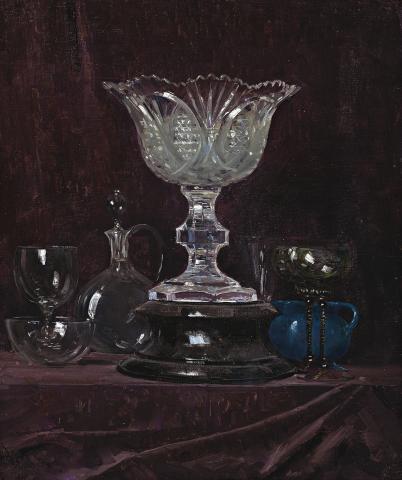GLASS, 1929
ARTHUR STREETON
oil on canvas on composition board
61.0 x 51.0 cm
signed lower left: A STREETON
The artist, Melbourne
Private collection
Gregson Flanagan Fine Art, Perth, 15 November 1994, lot 100
Private collection, Tasmania
Exhibition of Oil Paintings by Arthur Streeton, The Fine Art Society’s Gallery, Melbourne, 17 – 28 March 1931, cat. 15
Streeton, A., The Arthur Streeton Catalogue, Melbourne, 1935, cat. 1023, p. 89 (illus.)
Light is central to Arthur Streeton’s art. From Golden Summer, Eaglemont, 1889 (National Gallery of Australia, Canberra), through its subtle play in ‘Still glides the stream, and shall forever glide’, 1890 (Art Gallery of New South Wales, Sydney), to the grandeur of ‘The purple noon’s transparent might’, 1896 (National Gallery of Victoria, Melbourne), Streeton evokes the ineffable through his use of light, giving the magic of poetry to all that it touches. The waters of Sydney Harbour and the Grand Canal in Venice gave him further opportunities to display his mastery of the sparkle of sunlight. In Glass, 1929 we have another, extraordinary in the way it brings such eye-catching movement into a ‘still’ life. Common as glass may be, it still possesses a contradictory brilliance, a strength in its beauty that belies its frailty. Streeton conjures this up in a painterly conversation of intriguing shapes and tactile surfaces. The smooth elegance of the vase, decanter, wine glasses and bowls is contrasted with the velvet feel and folds of the material covering the table on which they stand. Glass reveals him to be a master of the tactile.
Seemingly unique in Streeton’s oeuvre as a subject in its own right, Glass was shown in his 1931 exhibition at the Fine Art Society’s Gallery, Melbourne. It was surrounded by landscapes of the Murray, Kosciusko, Olinda, and flower paintings of roses and tulips. While praising Streeton’s ‘unerring vision and sense of colour and atmosphere’ in his landscapes, Harold Herbert, then art critic for the Melbourne Argus newspaper, turned to the flower pieces. In describing ‘many of them bunched in a bowl of cut crystal’, Herbert took into his account the glass as an object of admiration. ‘The bowl itself is an object lesson in still-life painting, [he wrote] but the flowers have a quality which almost enables them to be felt and touched.’1 That same sense of the tangible permeates Glass, the darkened background providing the perfect foil for the sparkle of light, highlighting the cut of the crystal and the roundness of bowl and decanter in its convincing illusion of form. As if to counter the limitation of colour, Streeton added the bright blue jug to the right, as if to lead the eye into discovering the colour subtleties in the other pieces. While his paintings of flowers in their crystal vases have the added attraction of enticement of the senses through their imagined perfumes, his concentration on glass alone weaves its own magic. One cannot, nor wants to, escape its entrancing sparkle.
1. Herbert, H., ‘Art of Arthur Streeton. Sunlit Landscapes. Beautiful Flower Pieces’, Argus, Melbourne, 17 March 1931, p. 8
DAVID THOMAS
